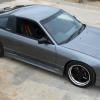Announcements
-
Similar Content
-
Latest Posts
-
By joshuaho96 · Posted
Most likely your engine is toast, but also the R32 GTR has different ratios than the GTS4. In 5th it's basically the same, it's mostly 1st through 3rd that change. Stop trying to do WOT pulls before you make the engine entirely unsalvageable. Do a leakdown test and/or borescope the cylinders first. And a boost leak can overspeed a turbo. Make sure the turbo actually functions as intended. -
By Dose Pipe Sutututu · Posted
Red Bull, if you're reading this thread, please sponsor us 🥲 -
By robbo_rb180 · Posted
Just need to find some sponsor dollars and we'd be good to go. -
By Dose Pipe Sutututu · Posted
I reckon if we all banded together, we'll make a great race team (build, fab, tune, pit, race) all under one roof. No need for external vendors.





Recommended Posts
Create an account or sign in to comment
You need to be a member in order to leave a comment
Create an account
Sign up for a new account in our community. It's easy!
Register a new accountSign in
Already have an account? Sign in here.
Sign In Now